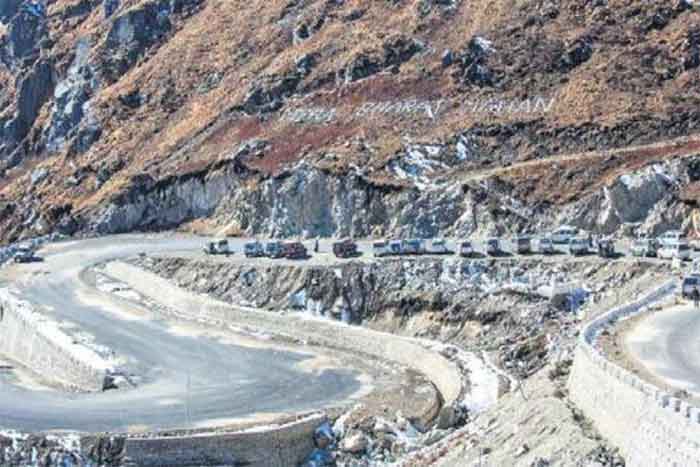
Recently there was a report of a woman in great pain in a remote village of Himachal Pradesh who had to be carried on back for over five miles by family members for treatment as no transport or even road was available in her village. This was by no means a very exceptional case. Such reports in fact appear from time to time in local newspapers. But equally frequent are reports about very expensive highway and tunnel projects being approved. Around the same time as this report on the woman being carried in great pain appeared, there were several reports of a series of expensive tunnels being approved in Himachal Pradesh and Uttarakhand.
One such project announced is the Mussorie Bypass Tunnel taken up for easing traffic congestion at the cost of Rs. 700 crore ( one crore=10 million), while endangering about 3000 oak, deodar and other trees. In addition the water and moisture retaining natural system of water conservation created by porous limestone would be badly disrupted.
A much bigger tunnel construction spree is ongoing and proposed In Himachal Pradesh. On June 24 recently, the Union Minister for Road Transport and Highways Nitin Gadkari, while visiting Atal Tunnel in this state, said 19 tunnels would be constructed in Himachal Pradesh. He said that work was in progress on 8 tunnels while the work on 11 tunnels would be ‘awarded’ soon. The Minister also laid the foundation stone of nine road projects of 222 km worth Rs 6,155 crore by video-conferencing.
It is not known how many of these projects have been assessed carefully in an unbiased way for their environmental and social impacts and whether announcements for awarding contracts are made before or after such careful and unbiased assessments. However what is well-known is that many of these projects are being taken up in ecologically very vulnerable and crucial areas, including catchment areas of very important rivers and their tributaries. It is also well-known that many of these projects involve very large-scale felling of trees whose numbers are often underestimated officially but despite this the number is still very high. Overall in the entire Himalayan region the number of trees felled and damaged recently and endangered by such works would be in some hundred thousands( lakhs ).
Construction work for these including blasting and boring can damage the geologically fragile and unstable hills immensely, also leading to landslides which can defeat the original objective of facilitating and speeding traffic. Other disasters can also be aggravated. Damage to water sources and springs, nearby houses and shops, deposition of rubble and displacement of people are other problems. There are innumerable complaints of displaced people regarding lack of proper compensation ( sometimes lack of any compensation, as in the case of those who lack ownership papers).
Careless construction adds to these problems. A recent ( 14.6.21) report in Bhaskar newspaper on Urla-Nausha road in Himachal Pradesh stated that due to neglect of drainage aspect with the initial monsoon the road resembled a nullah and a lot of water was diverted towards agricultural fields nearby, damaging crops. Villagers quoted in this report alleged that the entire work procedures are aimed at making more money and even after a lot of budget has been spent the condition does not seem to improve. On the same day Amar Ujala newspaper reported on the going Kalka-Shimla highway widening work that with the initial monsoon a lot of water and debris was diverted towards houses near Kumrhatti. This was attributed to carelessness in construction to which the affected people had drawn attention but their pleas had gone unheeded, the report said. An accompanying report from Kandhar-Bairal Road that the debris created by its cutting work had led to the burying of the water sources in remote Mangal Panchayat area ( Himachal Pradesh).
Suresh Bhai, a social activist based in Uttarkashi district ( Uttarakhand) who has been pointing out the hazards of careless highway widening says, “ Our on-the-site investigations revealed that one big tree is cut several nearby smaller trees are also damaged in the process. Cutting of trees causes landslides at new places and this in turn leads of loss of more trees.”
He along with senior Gandhian Radha Behan and other activists prepared a detailed report about 2 years back which showed the havoc that has been caused to the forests and trees of such eco-sensitive zones as the Gangotri region, where the Ganga river ( known here as the Bhagirathi ) originates. In addition this report depicted numerous ways in which indiscriminate construction activity is likely to cause disasters similar to the floods which devastated Uttarakhand in 2013. The report also shows how many villagers , farmers and small-market shopkeepers feel threatened as their homes and places of livelihoods face increasing risks of landslides and floods as a result of the fragile, geologically young hills being disturbed by the use of heavy machinery and blasting in the course of the highway construction work. Enormous amount of debris and rubble have been poured into rivers and this is a prescription for disasters as this can unleash and aggravate floods in the rainy season.
In fact if instead of driving straight on in highways, one ventures into nearby villages and habitations one gets a very different view of the ‘development’ by highways and their widening. I tried to do this about two years back on the Parwanoo-Solan ongoing widening stretch of Shimla-Kalka highway. Mangoti Nande Ka Thara used to be a beautiful, picturesque roadside village on this highway but when I visited this village it had been turned into a badly threatened village where farms had been devastated and cracks have started appearing in the hills. Anil Kumar said, “ Such a big crack has appeared in my house that the administration asked me to vacate the house. I have vacated my house but where do I go now? For the time being my family has taken shelter in my brother’s home but the cracks appear to be spreading there.” Two cowsheds had also collapsed. The villagers remained awake on rainy nights fearing disaster. Several villagers the entire future of the village is badly threatened.
They had received compensation for their land acquired earlier, they said, but the damage they suffered later as a result of the ruthless and indiscriminate construction not suitable for these fragile hills later was what harmed them most.
Further on the road, on the journey towards Solan, I came across similar threatening conditions in other roadside habitations –in Sanwara village, in Hardinge colony near Dharampur and also in some places near Kumarhatti.
Clearly there is much need for improvement in which highway and related construction and widening are being speeded up in the Himalayan region and several flaws need to be corrected. These flaws include—road widening to a wider extent than desirable, use of improper methods for hill-cutting, hurry to award big contracts without taking independent and unbiased expert opinion ( particularly on geological, ecological and social impacts ) , inviting only those experts whose views are supportive towards contracts, avoiding proper environmental and social appraisal, sub-dividing projects into smaller portions to avoid mandatory appraisals and public hearings, excluding local communities from decision-making and monitoring processes, adopting top-heavy, arbitrary and centralized approach.
Announcements of new projects are often made in grand, royal style from the top without local people being even aware of any consultations and appraisals. Experts with best knowledge of local conditions are left wondering why no one even approached them for their opinion.
Local people often say that if facilitating traffic is the objective, this can be achieved at much lower economic and ecological costs. Unfortunately what one sees in reality is often a maximization of ecological and social costs instead of striving to minimize them. Several roads are becoming more risky with billboards warning about the risk of falling stones in destabilized hills.
A review of all the highway construction and widening projects in the Himalayan region should be taken up so that adequate precautions to minimize social and environmental costs can be taken and mistakes which have proved so costly in the past in some of these projects are not repeated elsewhere.
Much can still be done to reduce the ecological and social adverse impacts by involving local people. In Matehal Panchayat of Karsog region ( Himachal Pradesh), for example, when the administration did not listen to repeated pleas for repairing a badly damaged important 3 km stretch of road, women of this panchayat joined hands together to contribute voluntary labor and substantially repaired the road on their own. This is just one recent indication that if instead of a contract centered approach, there is a people and environment centered approach then both people will benefits more and ecology will be better protected. This will involve a shifting of priorities from shine to need, from speed to stability, with more funds for keeping village paths in good condition and less for big budget prestige projects.
Bharat Dogra is Honorary Convener, Save the Earth Now Campaign. His recent books include Planet in Peril and Man Over Machine.








































